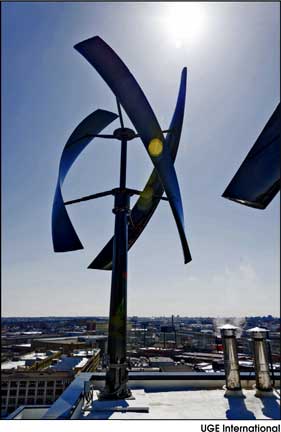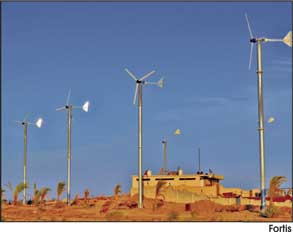by MARY M. COX
Manufacturer List
|
According to data published by the Global Wind Energy Council, Asia is now the leading user of wind energy, surpassing the previous leader, Europe. The total installed capacity for Asia is projected to amount to 40 to 45 percent of the overall market by 2020. As for the other large users of this resource, Europe’s usage is also expected to fulfill the Council projections for the next five years. North American projections are not as firm, due to a handful of variables involving the U.S. and Canada. Latin America is expected to make some gains in usage and Africa too, although taking a bit longer to do so, compared to Latin America. Not surprisingly, more than one company lays claim to be the leading manufacturer of wind turbines in the world, and the projections published by the Council indicate continued market growth for those who manufacture wind turbines. One of those companies provided us with a view of their particular position in the market.

“UGE International is a global leader in renewable energy solutions. We have over 2,000 projects in over 100 countries, including a recent installation of 2 VisionAIR wind turbines on the Eiffel Tower. Our solutions for commercial and industrial clients include solar, wind, hybrid and energy storage solutions. Installation of some turbines can be done very quickly – often within a single day,” stated Nick Blitterswyk, chief executive officer.
UGE started as a manufacturer of small wind turbines in 2008 and although UGE has transitioned to a solar and hybrid solutions-focused company, the company continues to pioneer technology in small wind space, producing turbines at their own factory.
Blitterswyk said that as a result of years of research, UGE designs and manufactures three different vertical axis wind turbines (VAWT) for commercial use:
- The VisionAIR3, the smallest turbine offered, is 3.2m high and 1.8m in width. Designed to be the lightest weight in the industry, the VisionAIR3 blades are made from fiberglass and the turbine weighs in at 274 kg.
- The VisionAIR5 is UGE’s most commonly ordered and installed turbine, at 5.2m high and 3.2m in width. Similar to the VisionAIR3, the blades are made from fiberglass and weight is 756 kg. Two of these turbines currently sit on the Eiffel Tower producing 10,000 kwH of electricity each year from 400m above the ground.
- The UGE 9m is the firm’s largest turbine, at 9.6m high and 6.4m in width. The blades are made from carbon fiber and fiberglass with steel re-inforcement.

According to Blitterswyk, UGE turbines are the only vertical axis wind turbines with certified power curves that produce affordable energy with a small footprint. Due to the vertical axis and design of the blades, UGE turbines are capable of capturing wind from any direction. “The design of the turbine is the most innovative in the industry with helical blades, and a double axis generator. Small wind turbines are ideal for use in areas with wind speeds of at least 11.2 mph, and are good for areas where limited space is a concern – for example, a roof may not have enough area for a solar array or may have limited solar resources. Unlike utility scale turbines, VAWTs are designed for producing energy to be consumed on-site,” Blitterswyk stated.
He noted that energy density is a challenge in the distributed energy space, because buildings may not have enough space to install systems that can significantly offset electrical loads. The term “energy density” refers to the amount of energy capable of being generated in a given area. Blitterswyk added, “Compared to solar, VAWTs have really high energy density, which makes them the ideal choice for a variety of settings. Our turbines work atop a hotel in Miami, the Lincoln Financial Field in Pennsylvania, and for a telecom tower along the Iraqi/Syrian border in Jordan – proving that small scale wind has a variety of applications. One of the other most commonly cited concerns can involve the noise level of wind turbines. However, UGE’s turbines are AWEA rated at 38 – 41 dBA, which means they are as quiet as a human whisper.”
As solar power is another prominent source of renewable energy, Blitterswyk described some advantages of wind energy, compared to solar power: “When solar power is the only energy source in place with a given facility, two issues may emerge – along with added cost. For instance, more energy storage may be required, as sometimes there may not be enough solar insolation to offset the energy load. Solar power also may not provide the energy level needed, due to the low energy density of solar panels and the space limitation of a given project site. Our VAWT products can mitigate such problems because they provide energy when the sun is down, and have a much higher energy density than solar panels. Solar and wind are actually complementary resources – often the sun is not shining when the wind is blowing, and vice versa. Hybrid technology that combines wind and solar, and sometimes energy storage, have already started to dominate the renewable energy world. Many sites that incorporate solar and storage rely on diesel gensets as a backup power – a dirty and expensive fuel option. Combining wind with solar technology can eliminate the need for a diesel genset and provide cleaner, less expensive energy.”

Fortis, another wind turbine manufacturer, has over 6,400 of their units in place worldwide, many in locations with extremely harsh environments. The firm provides on and off grid systems along with hybrid microgrid systems, which can also be integrated with the other systems offered. On grid systems can be connected to a public distribution network. This grid connect wind turbine can reduce utility supplied electricity and excess energy may also be returned to the public utility. Local incentives may even be offered for use of such systems. Coordinating with the local utility is recommended before choosing the best system for your needs and to confirm all, relative to safety parameters. The on grid system is a stand-alone unit that can store back up energy, charge batteries and works well for isolated areas. The turn key wind and solar systems offered by Fortis combine the two different but complementary resources and can be monitored locally and remotely.
According to Lucienne van Oostveen, marketing and communication, EWT is a leading wind turbine supplier for distributed wind energy applications. With turbines generating electricity for customers from Alaska, mainland U.S., across Europe and through to Asia, EWT represents the technology of choice for many parts of the distributed wind energy sector. “We offer a highly efficient product range based on direct drive technology with a high yield, low cost of energy and high quality availability levels. Our company focuses on offering cost-effective energy solutions to heavy energy users, ranging from turbine supply to full energy provision,” van Oostveen stated.
Published in the November 2015 Edition of American Recycler News









